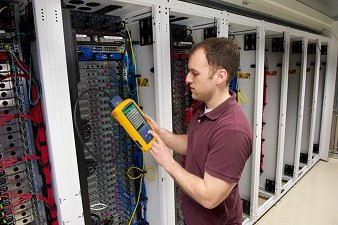Certification vs. Qualification: A Closer Look
September 30, 2015 / General
cer·ti·fy \ˈsər-tə-ˌfī\ verb 1: to attest authoritatively 2: to officially recognize someone or something as possessing certain qualifications or meeting certain standards
qual·i·fy \ˈkwä-lə-ˌfī\ verb 1: to have the necessary skill or knowledge to do a particular job or activity 2: to have the qualifications to do something
Since the dawn of cable plant testing and TIA and ISO cabling standards, there has been confusion in the industry surrounding the difference between certification and qualification testing. While just taking a look at the Merriam-Webster definition for “certify” and “qualify” may sum it up for some, let’s take a closer look at the difference between these two testing methods.
Certification—The Most Rigorous of All Testing
 Used primarily by commercial contactors and network technicians, certification testing determines if a link is compliant with a specific category or Class of cable as determined by well-defined parameters outlined in ANSI/TIA-568-C.2 or ISO/IEC standard 11801 (ed. 2). For instance, certification testing will determine if your link is compliant with Category 6 or Class EA standards.
Used primarily by commercial contactors and network technicians, certification testing determines if a link is compliant with a specific category or Class of cable as determined by well-defined parameters outlined in ANSI/TIA-568-C.2 or ISO/IEC standard 11801 (ed. 2). For instance, certification testing will determine if your link is compliant with Category 6 or Class EA standards.
To certify a link to a standard, a certification tester must test for all of the specific parameters required by the standards. For copper, this includes parameters that go well beyond basic length, continuity and wiremap testing. We’re talking about parameters like insertion loss, return loss, near-end crosstalk (NEXT), power sum NEXT, equal-level far-end crosstalk (ELFEXT), attenuation-to-crosstalk ration (ACR) and more. For fiber, it means testing for things like continuity, polarity, length and insertion loss (Tier 1) or backscatter, reflectance, optical return loss (Tier 2).
While we won’t go into detail on all of these parameters, the key takeaway here is to understand that certification testing results in either a “Pass” or “Fail” in accordance with TIA and ISO standards. Certification testing also requires that the test data for each link is collected, stored and available for future inspection.
Qualification—Simply Determining Application Support
Just as the Merriam-Webster definition implies, qualification testing is determining whether the cabling has the qualifications to do something—in other words, support a certain network speed or application. While a “Pass” on certification testing also ultimately indicates the ability to support a network speed or application per the standards, qualification testing does NOT officially recognize that a cabling link is standards compliant.
Qualification testing might be used to determine if a link can support 1000BASE-T, 10GBASE-T, VoIP, PoE or other applications. Rather than testing to specific performance parameters, this method of testing essentially simulates the applications to determine if the cable works properly, looking at attributes like bit error rates.
Which One Do I Use?
If you need to prove that copper and/or fiber cabling meets TIA and ISO standards, which is almost always required to attain the support and security of a manufacturer’s warranty, certification testing is your only option. When troubleshooting, certification testing is also the only way to demonstrate unequivocally that a link is failing the performance requirements of the standards.
Keep in mind that certification testers must also meet TIA/ISO Level III or higher accuracy requirements. In other words, to certify to the standards, the tester itself must also be standards compliant. Meeting accuracy Level IV and draft accuracy Level V, Fluke Networks DSX-5000 CableAnalyzer is the ideal tool for certifying copper and fiber cabling in accordance with TIA and ISO/IEC standards.
Depending on the situation, sometimes certification testing is overkill. For example, if the cabling has already been installed and certified and you need to determine if it will support 10GBASE-T, qualification testing is likely the right choice. Qualification testing is also ideal for simple troubleshooting like distance to a break or wiremap, when setting up temporary networks or following small moves, adds and changes.
If qualification is all you need, a great cost-effective everyday qualification tester is the Fluke Networks CableIQ. It qualifies existing cabling to determine if it has the bandwidth to support your applications, while also offering powerful troubleshooting capabilities.




